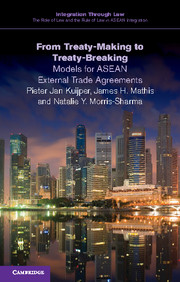Abbott, K. W. and Snidal, D. 2000. ‘Hard and Soft Law in International Governance’, International Organization, 54: 54–421.
Chesterman, S. 2008. ‘Does ASEAN Exist? The Association of Southeast Asian Nations as an International Legal Person’, Singapore Yearbook of International Law, 12:12–199.
Chinkin, C. 1989. ‘The Challenge of Soft Law: Development and Change in International Law’, International and Comparative Law Quarterly, 38: 38–850.
Conforti, B. 1994. ‘The Theory of Competence in Verdross’, European Journal of International Law, 5:5–1.
Cremona, M. 2010. ‘Disconnection Clauses in EU Law and Practice’, in C., Hillion and P., Koutrakos (eds.), Mixed Agreements Revisited: The EU and its Member States in the World. Hart Publishing pp. 160–86.
De Baere, G. 2008. Constitutional Principles of EU External Relations. Oxford University Press.
Dorr, O. and Schmalenbach, K. (eds.). 2012. Vienna Convention on the Law of Treaties: A Commentary. Springer.
Ehlermann, C. D. 1983. ‘Mixed Agreements: A List of Problems’, in D., O'Keeffe and H. G., Schermers (eds.), Mixed Agreements. Kluwer Law and Taxation, pp. 3–21.
Footer, M. E. 2010. ‘The (Re)turn to “Soft Law” in Reconciling the Antinomies in WTO Law’, Melbourne Journal of International Law, 11: 11–241.
Gaja, G. 1983. ‘The European Community's Rights and Obligations under Mixed Agreements’, in D., O'Keeffe and H. G., Schermers (eds.), Mixed Agreements. Kluwer Law and Taxation, pp. 133–40.
Groux, J. 1983. ‘Mixed Negotiations’, in D., O'Keeffe and H. G., Schermers (eds.), Mixed Agreements. Kluwer Law and Taxation, pp. 87–96.
Gruchalla-Wesierski, T. 1984. ‘A Framework for Understanding “Soft Law”’, McGill Law Journal, 30: 40.
Guzman, A. T. and Meyer, T. L. 2010. ‘International Soft Law’, Journal of Legal Analysis, 2:2–171.
Hafner, G. 2003. ‘Can International Organisations be Controlled? Accountability and Responsibility’, American Society of International Law Proceedings, 97: 97–236.
Hartley, T. C. 2007. The Foundations of European Community Law: An Introduction to the Constitutional and Administrative Law of the European Community. Oxford University Press.
Heliskoski, J. 2001. Mixed Agreements as a Technique for Organising the International Relations of the European Communityand its Member States. Kluwer Law International.
Heliskoski, J. 2010. ‘Adoption of Positions under Mixed Agreements (Implementation)’, in C., Hillion and P., Koutrakos (eds.), Mixed Agreements Revisited: The EU and its Member States in the World. Hart Publishing, pp. 138–59.
Hix, J. P. 2008. ‘Mixed Agreements in the Field of Judicial Cooperation in Civil Matters: Treaty-making and Legal Effects’, in B., MartenczukandS., Van Thiel (eds.), Justice, Liberty, Security: New Challenges for EU External Relations. VUBPRESS Brussels University Press, pp. 211–56.
Hoffmeister, F. 2010. ‘Curse or Blessing? Mixed Agreements in the Recent Practice of the European Union and its Member States’, in C., Hillion, and P., Koutrakos (eds.), Mixed Agreements Revisited: The EU and its Member States in the World. Hart Publishing, pp. 249–68.
Horn, H., Mavroidis, P. and Sapir, A. 2010. ‘Beyond the WTO? An Anatomy of EU and US Preferential Trade Agreements’, World Economy, 33: 33–1565.
Kin, L. C. and Joy, N. E. (eds.). 2012. Your Country Guide to ASEAN Competition Law. Drew & Napier.
Klabbers, J. 1996. ‘The Redundancy of Soft Law’, Nordic Journal of International Law, 65: 65–167.
Kuijper, P. J. 2008. Of ‘Mixity’ and ‘Double-Hatting’: EU External Relations Law Explained. Amsterdam University Press.
Kuijper, P. J. 2010. Conflicting Rules and Clashing Courts. The Case of the WTO, Multilateral Environmental Agreements and Free Trade Agreements. ICTSD.
Macleod, I., Hendry, I. D. and Hyett, S. 1996. The External Relations of the European Communities. Oxford University Press.
Murray, P. 2005. ‘Should Asia Emulate Europe?’ in W., Moon and B., Andreosso-O'Callaghan (eds.), Regional Integration: Europe and Asia Compared. Ashgate, pp. 197–213.
Nollkaemper, A. and Jacobs, D. 2013. ‘Shared Responsibility in International Law: A Conceptual Framework’, Michigan Journal of International Law, 34: 34–359.(Also available as SHARES working paper 2011/03 (revised 2012 version) on the SHARES website at: www.sharesproject.nl/publication.)
Olson, P. 2010. ‘Mixity from the Outside: The Perspective of a Treaty Partner’, in C., Hillion and P., Koutrakos (eds.), Mixed Agreements Revisited: The EU and its Member States in the World. Hart Publishing, pp. 331–48.
Palchetti, P. 2011. ‘Article 18 of the 1969 Vienna Convention: A Vague and Ineffective Obligation or a Useful Means of Strengthening Legal Cooperation?’ in E., Cannizzarro (ed.), The Law of Treaties Beyond the Vienna Convention. Oxford University Press, pp. 25–36.
Pauwelyn, J. 2003. ‘A Typology of Multilateral Treaty Obligations: Are WTO Obligations Bilateral or Collective in Nature?’, European Journal of International Law, 14: 14–907.
Rosas, A. 1998. ‘Mixed Union: Mixed Agreements’, in M., Koskenniemi (ed.), International Law Aspects of the European Union. Martinus Nijhoff, Kluwer Law International, pp. 125–48.
Rosas, A. 2010. ‘The Future of Mixity’, in C., Hillion and P., Koutrakos (eds.), Mixed Agreements Revisited: The EU and its Member States in the World. Hart Publishing, pp. 367–74.
Schermers, H. G. 1983. ‘A Typology of Mixed Agreements’, in D., O'Keeffe and H. G., Schermers (eds.), Mixed Agreements. Kluwer Law and Taxation, pp. 23–33.
Smyth, I. 2010. ‘Mixity in Practice: A Member State Practitioner's Perspective’, in C., Hillion and P., Koutrakos (eds.), Mixed Agreements Revisited: The EU and its Member States in the World. Hart Publishing, pp. 304–19.
Solingen, E. 2008. ‘The Genesis, Design and Effects of Regional Institutions: Lessons from East Asia and the Middle East’, International Studies Quarterly, 52: 52–261.
Tomuschat, C. 1983. ‘Liability for Mixed Agreements’, in D., O'Keeffe and H. G., Schermers (eds.), Mixed Agreements. Kluwer Law and Taxation, pp. 125–32.
Tomuschat, C. 2002. ‘The International Responsibility of the European Union’, in E., Cannizzaro (ed.), The European Union as an Actor in International Relations. Kluwer Law International, pp. 177–92.
Weiler, J.H.H. 1983. ‘The External Legal Relations of Non-unitary Actors: Mixity and the Federal Principle’, in D., O'Keeffe and H. G., Schermers (eds.), Mixed Agreements. Kluwer Law and Taxation, pp. 35–83.
WTO, Secretariat. 2011. The WTO and Preferential Trade Agreements: From Co-existence to Coherence. Economic Research and Statistics Division, available at: www.wto.org/english/res_e/reser_e/wtr_e.htm.





